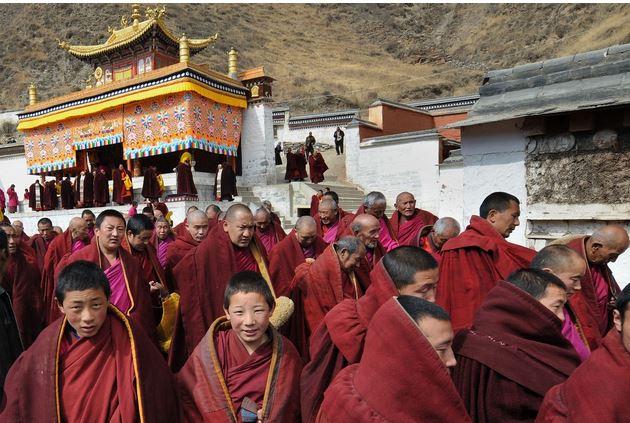Tibetan Buddhism

Tibetischer Buddhismus, or Tibetan Buddhism, is a major form of Buddhism that developed in Tibet and is practiced in regions like Bhutan, Nepal, Mongolia, and parts of India. It blends elements of Indian Buddhism with the native Tibetan Bon religion and incorporates unique practices and teachings. Here are some key aspects:
1. Origins and History
-
Arrival in Tibet: Buddhism was introduced to Tibet in the 7th century by King Songtsen Gampo, who married two Buddhist princesses and supported the spread of the religion.
-
Later Development: In the 11th century, Buddhism flourished with the work of scholars like Atisha, and it was further shaped by the teachings of various Indian and Tibetan masters.
2. The Four Main Schools of Tibetan Buddhism
Tibetan Buddhism is divided into four major schools, each with its own emphasis and interpretation of Buddhist teachings:
-
Nyingma: The oldest school, founded on the teachings of Padmasambhava (Guru Rinpoche), who is credited with bringing Buddhism to Tibet. Nyingma emphasizes Dzogchen (the "Great Perfection"), focusing on realizing the nature of the mind.
-
Kagyu: Known for its focus on meditation and the direct transmission of teachings, particularly from Milarepa, a famous Tibetan yogi. The Kagyu lineage emphasizes practices like "Mahamudra" and "Trekchö."
-
Sakya: Known for its scholarship and monastic discipline. It has a rich tradition of scholarly texts and teachings, especially around the Lamdre (Path and its Result) system.
-
Gelug: Founded by Je Tsongkhapa in the 14th century, it is the school most associated with the Dalai Lama. The Gelug emphasizes monastic discipline, study, and debate, focusing on analytical meditation.
3. Key Practices
-
Meditation: Tibetan Buddhism places a strong emphasis on meditation, both analytical and experiential. This includes practices such as shamatha (calm-abiding meditation) and vipassana (insight meditation), as well as more advanced techniques like Mahamudra and Dzogchen.
-
Mantras and Rituals: Reciting mantras, like the well-known "Om Mani Padme Hum," is a key practice for purifying the mind and accumulating merit. Rituals, offerings, and prayers are integral to daily life.
-
Deity Yoga: Practitioners visualize themselves as Buddhas or bodhisattvas, invoking divine qualities to overcome delusions and develop compassion.
4. The Concept of Reincarnation
Tibetan Buddhism believes in the cycle of birth, death, and rebirth (samsara), and that spiritual liberation (nirvana) is achieved through the cessation of this cycle. The tulku system is central to Tibetan Buddhism, wherein certain highly realized beings, like the Dalai Lama, are believed to reincarnate consciously to continue their work for the benefit of sentient beings.
5. Lamas and Spiritual Leaders
-
Dalai Lama: The spiritual leader of Tibetan Buddhism and the head of the Gelug school. The Dalai Lama is considered a tulku (a reincarnated lama) and is revered as an embodiment of compassion.
-
Rinpoche: A title given to highly respected teachers, often tulkus, who are considered to be incarnations of past masters. These teachers guide their students in meditation and philosophy.
6. Philosophy
Tibetan Buddhist philosophy is grounded in the teachings of emptiness (shunyata) and the interdependence of all phenomena. Emphasizing wisdom (prajna), ethical conduct (sila), and mental discipline (samadhi), the goal is to understand the nature of reality and to cultivate compassion for all sentient beings.
7. The Role of Compassion and Bodhicitta
Compassion (karuna) and the wish to attain Buddhahood for the benefit of all beings (bodhicitta) are central to Tibetan Buddhist practice. Practitioners engage in the Six Perfections (paramitas) — generosity, morality, patience, effort, concentration, and wisdom — to develop their inner qualities.
8. Sacred Texts
Tibetan Buddhism relies on a vast array of sacred texts, including:
-
Kangyur: The collection of teachings attributed to the Buddha.
-
Tengyur: Commentaries on the teachings, written by great scholars.
-
Terma: Hidden teachings revealed by great Tibetan masters like Guru Rinpoche.
9. Art and Symbols
Tibetan Buddhism is famous for its colorful and intricate thangkas (painted scrolls), mandalas (spiritual diagrams), and masks used in rituals. These artworks often depict Buddhas, bodhisattvas, and deities, and serve as tools for meditation and contemplation.
In sum, Tibetan Buddhism is a rich and multifaceted tradition that blends ancient Indian teachings with the unique culture of Tibet. Its focus on meditation, ritual, compassion, and wisdom makes it a profound path to spiritual realization.

